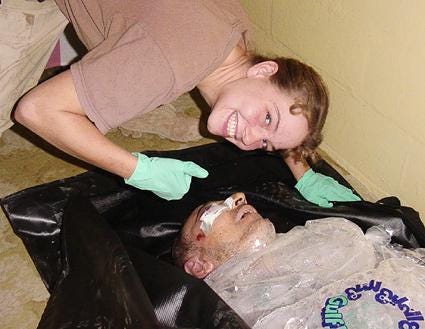CIA Finally Admits to Hand in Iraq Detainee’s Death
Navy SEALs were punished for 2003 death of Manadel al-Jamadi while he was under CIA interrogation
For years now, the CIA and the Navy SEALs have worked side-by-side on highly-classified missions battling terrorists around the globe.
When things go right, the result can be nothing short of spectacular. The daring 2011 Navy mission into Pakistan that resulted in the death of Al Qaeda kingpin Osama bin Laden was not only a miraculous success but a publicity coup for both the CIA and the members of SEAL Team Six that led the raid. Both revelled in the glory.
When things go wrong, however, the blame is not always equally shared. A case in point: the death of an Iraqi insurgent in U.S. hands in Iraq.
The CIA and the SEALs follow different rules, report to different chains of command, and are ultimately accountable to two different systems of justice. How those two different systems play out when things go wrong is a theme of a book I’m writing on the death of Manadel al-Jamadi, an Iraqi insurgent captured by the SEALs in 2003.
Jamadi’s name may not be familiar, but there’s a good chance you’ve seen his face. His beaten and bloodied visage appeared in some of the nightmarish images from the notorious Abu Ghraib prison scandal. Photos showed U..S soldiers giving a thumbs-up over Jamadi’s ice-packed corpse. The title of my book comes from a nickname the guards gave the dead prisoner, The Ice Man.

U.S. Army guards in the prison reported that CIA personnel had stood by idly while Jamadi died. Internal CIA documents I’ve obtained show that a military pathologist concluded that the position Jamadi was placed in was “part and parcel” of a homicide. He had been suspended by his wrists, which were handcuffed behind his back. One guard said he was surprised that Jamadi’s shoulders didn’t “pop out of their sockets.”
Someone had to be held accountable for this disaster. It turned out to b the Navy SEALs.
Even though the only people in the room when Jamadi died were a CIA polygraph examiner on temporary duty in Iraq and a translator (agency unknown), the ones held accountable in Jamadi’s death were members of the SEAL platoon that captured him in a top-secret, direct-action mission.
The charges against the SEALs centered on allegations that they had kicked and punched Jamadi on the way back to their base when he refused to stop talking. The SEALs were hauled into military court and threatened with prison for abusing—but not killing—Jamadi and posing for pictures with him. Most received administrative discipline. One officer was acquitted at court-martial.
Evidence gathered during the proceedings revealed that the CIA had conducted brutal interrogations of detainees. Detainees were slapped, choked, subjected to terrifying mock assaults, doused with cold water, and had their joints stretched in painful ways, according to classified testimony from the SEALs I obtained for my book. One former SEAL told me that a CIA interrogator had used a large wooden mallet to frighten a prisoner by smashing it into the plywood wall near his outstretched hand.
Although the SEALs didn’t know it, this was a rogue interrogation program. Months before the news media’s exposure of its torture program, CIA headquarters had sent a detailed cable to the Baghdad station that spelled out limits on what agency personnel in Iraq could and couldn’t do in interrogations. “Enhanced” interrogation techniques were forbidden. The guidance in the cables was ignored.
“Either some people ... didn’t understand it, or chose in the heat of battle to go beyond it,” former acting General Counsel John Rizzo told the Constitution Project’s Task Force on Detainee Treatment. Rizzo died in 2021.
The CIA’s role in Jamadi’s death was investigated by prosecutors in the U.S. Attorney’s office in Alexandria, Virginia, led by Paul McNulty and Chuck Rosenberg, and Special Counsel John Durham. Prosecutors declined to file charges in both instances and no one at the CIA was ever held publicly accountable. The CIA station chief and two officers “were fired because they went beyond the guidelines,” Rizzo said.
News accounts tell a different story. The station chief, Gerry Meyer, “resigned rather than take a demotion,” the Associated Press reported. "Steve, a CIA officer who ran the detainee unit there, received a letter of reprimand,” former officials told the A.P. David Martine, chief of the CIA's Detention Elicitation Cell in Iraq, who was suspected of destroying evidence connected to Jamadi’s death, was also allowed to resign.

With help from attorneys at Loevy & Loevy, a Chicago-based firm specializing in civil rights and whistleblower cases, I filed a pair of lawsuits against the CIA to force it to disclose what happened to the Ice Man and the findings of an internal disciplinary board that reviewed the case.
Last week, the CIA produced a heavily redacted memo, dated June 22, 2007, in response to my lawsuit.
The memo, written by an assistant for then-CIA Inspector General John Helgerson, was titled “Comments on Report and Recommendations of the Special Accountability Board Regarding the Death of Iraqi Detainee Manadal al-Jamaidi.” (The CIA uses an alternate spelling of his name.)
After the Justice Department declined to prosecute anyone at the CIA in Jamadi’s death in 2006, the agency convened an internal accountability board to examine the case. What was the outcome? We don’t know. It’s classified.
A previously released version of this memo redacted Jamadi’s name and the acknowledgment that he “died during interrogation by the CIA.” This may not seem like much. I first reported that Jamadi died in CIA interrogation in a position the world recognizes as torture in 2005. But this is the first time that I’m aware the CIA has officially acknowledged it.
Keep reading with a 7-day free trial
Subscribe to SpyTalk to keep reading this post and get 7 days of free access to the full post archives.



